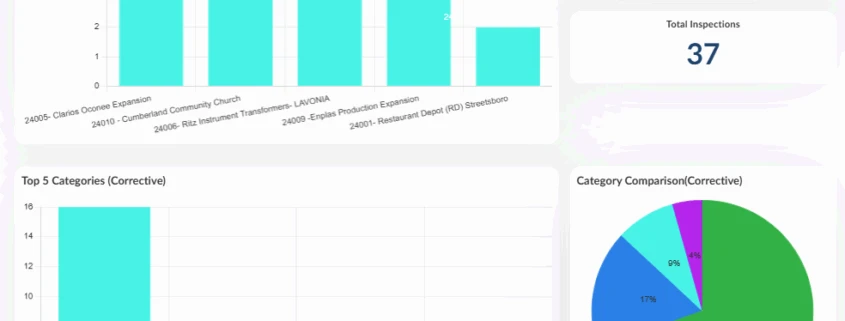How Construction Safety Software Is Revolutionizing the Industry
The construction industry is undergoing a digital transformation, and at its heart is a critical, lifesaving shift: the widespread adoption of construction safety software. No longer just a compliance checkbox, safety management software is rapidly becoming the backbone of efficient, proactive, and people-first job site management. From streamlining inspections to reducing insurance costs, the impact is undeniable. Let’s dive into how this technology is reshaping construction safety—and why companies that don’t adapt risk more than just falling behind.
Why Safety Is a Critical Concern in Construction
Construction remains one of the most dangerous industries in the world. Each year, 1.7% of construction workers suffer injuries serious enough to miss work, with the total annual cost of construction injuries exceeding $11.5 billion. These numbers aren’t just statistics—they’re stories of real people, and they underscore a harsh truth: traditional safety management methods are no longer enough.
Adding to this is the ongoing labor shortage, the rise in entry-level hires, and increased production pressure, all of which create an environment ripe for risk. As HB NEXT’s Tony Cann notes, “Workers are going too fast, are sometimes underqualified, and may not have enough safety resources. We’ve seen incidents increase because of these factors. Everybody’s overstretched.”
Key Features of Modern Construction Safety Software
Today’s leading construction safety management software, like Sequence XT by HB NEXT, goes far beyond spreadsheets and paper checklists. They offer integrated features that support a complete compliance lifecycle:
- Real-Time Inspection Management: Field teams can complete and submit customized safety inspections via mobile apps, instantly updating central dashboards.
- Credential and Training Tracking: Software ensures all employees have current safety training, with automated alerts for upcoming expirations.
- Incident Reporting & Case Management: Streamlined reporting tools help companies log, manage, and resolve incidents quickly and thoroughly.
- Telematics and Fleet Safety Monitoring: Integrated fleet data helps prevent driving violations before they become legal liabilities.
- Customizable Learning Management Systems (LMS): Companies can deliver microlearning modules and tailored training paths to upskill workers at scale.
These tools bring clarity, speed, and accountability to construction safety, transforming reactive approaches into data-driven prevention strategies.
How Software Solutions Are Preventing Accidents
Construction safety management software is saving lives—literally. By utilizing predictive analytics and centralized data, companies can identify trends before they become disasters. For example:
- Behavioral Trends: Knowing when and where incidents occur helps managers deploy resources more effectively.
- Automation of Safety Protocols: Weekly toolbox talks, inspection reminders, and training rollouts happen without manual follow-up.
- Risk Mitigation During Insurance Renewals: Companies can use safety data to negotiate more favorable premiums by demonstrating proactive risk management.
Companies like Fly & Form Structures have seen immediate changes after implementing HB NEXT’s software. “Now I can tell you what day of the week and what time of day our injuries happen… We’ve seen immediate changes in our program. Our EMR started going down right away,” said Charles Davis, their project and risk manager.
The ROI of Investing in Safety Software
Investing in construction safety software isn’t just about compliance—it’s about return on investment (ROI). According to OSHA, every $1 spent on safety yields a return of $4 to $6. Here’s why:
- Lower Insurance Premiums: A reduced EMR (Experience Modification Rate) and TRIR (Total Recordable Incident Rate) result in real dollar savings.
- Fewer Lawsuits: Thorough documentation protects companies from legal exposure in the event of an accident.
- Reduced Administrative Burden: Safety managers save time, allowing them to focus on higher-level safety strategy and culture.
- Stronger Bids: A robust safety record opens the door to bigger, more lucrative projects where owners demand strict compliance standards.
Moreover, software helps maintain business continuity, which is especially important in an era when competing companies frequently poach safety professionals, thereby increasing turnover.
Final Thoughts: Safety Is the New Competitive Advantage
Construction companies can no longer afford to view safety as a cost center. In today’s high-risk, high-expectation environment, construction safety software is a strategic advantage. It empowers teams to prevent incidents, lowers costs, improves morale, and makes companies more competitive when bidding for new work.
As HB NEXT has proven through its Compliance as a Service (CaaS) model, when management embeds safety into every process via powerful software, companies don’t just protect their workers—they unlock growth.
Want to learn how your construction company can benefit from safety management software?
Let’s discuss how HB NEXT can become your compliance partner. We can help companies understand how adding more technology without proper support might worsen their situation. To learn more about our safety management software, contact HB NEXT at (770) 619-1669 to schedule a free consultation or ask an expert for help today.




